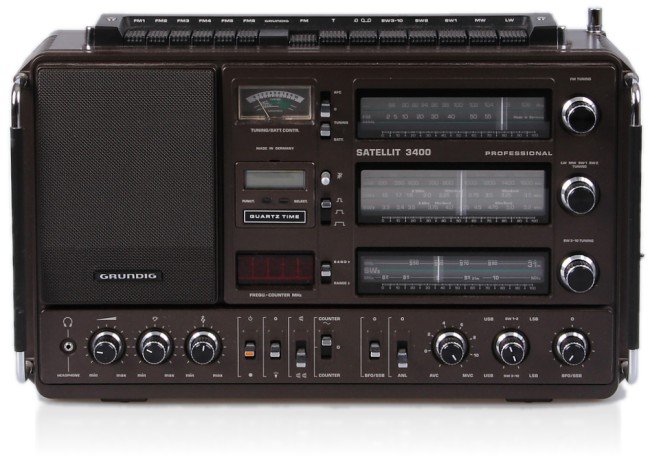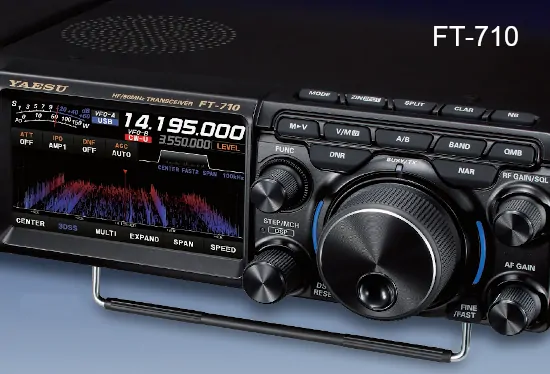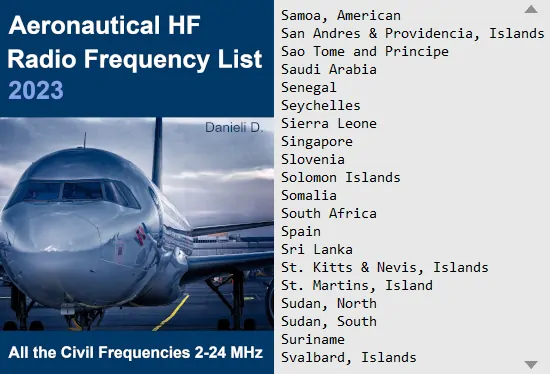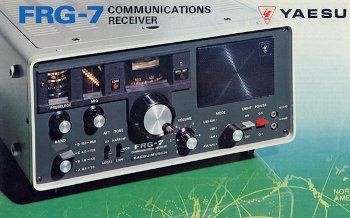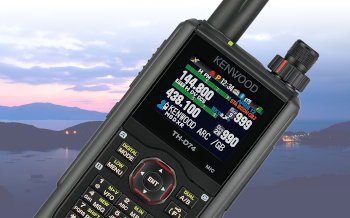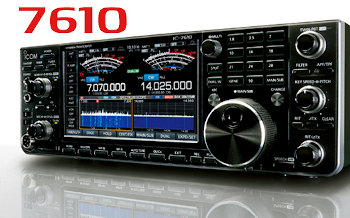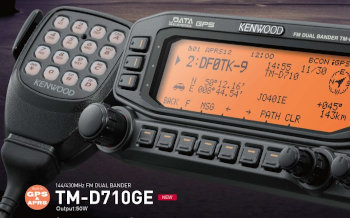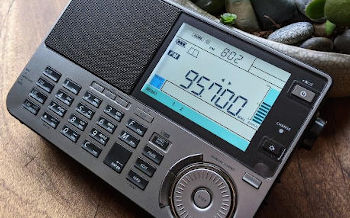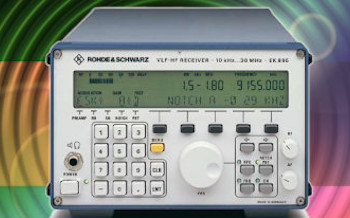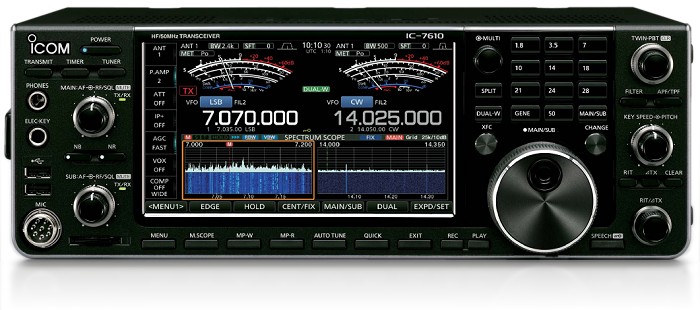
High performance HF/50 MHz transceiver with true dual RF direct sampling receivers and independent preselector circuits for the Main and Sub bands. Class leading Reciprocal Mixing Dynamic Range characteristics. 7-inch color display with touch screen function, 100W output power, automatic antenna tuner. Ideated in Japan, year of introduction 2017.
Reference market : amateur-radio
IC-7610 specifications
| General |
| Frequency coverage | |
|---|---|
| Receive | 0.0300 ~ 60.8000 MHz [1] |
| Transmit | 0.1357 ~ 0.1378 MHz [2] 1.8000 ~ 1.9999 MHz [3] 3.5000 ~ 3.9999 MHz [3] 5.2550 ~ 5.4050 MHz [4] 7.0000 ~ 7.3000 MHz [3] 10.1000 ~ 10.1500 MHz 14.0000 ~ 14.3500 MHz 18.0680 ~ 18.1680 MHz 21.0000 ~ 21.4500 MHz 24.8900 ~ 24.9900 MHz 28.0000 ~ 29.7000 MHz 50.0000 ~ 54.0000 MHz [3] |
| Mode | |
| CW / FSK (RTTY) / PSK / LSB / USB / AM / FM | |
| Tuning step | |
| 1 / 10 / 50 [5] / 100 Hz / 1 / 5 / 9 / 10 / 12.5 / 20 / 25 KHz | |
| Receiver |
| Sensitivity [6] | |
|---|---|
| CW | 0.16 uV (1.8~30 MHz, 10dB S/N, p.amp1 ON) 0.13 uV (50~54 MHz, 10dB S/N, p.amp2 ON) |
| SSB | 0.16 uV (1.8~30 MHz, 10dB S/N, p.amp1 ON) 0.13 uV (50~54 MHz, 10dB S/N, p.amp2 ON) |
| SSB [7][8] | < 10 dBuV emf (1.8~3 MHz, 12dB SINAD, p.amp1 ON) < 0 dBuV emf (3~30 MHz, 12dB SINAD, p.amp1 ON) < -6 dBuV emf (50~52 MHz, 12dB SINAD, p.amp2 ON) |
| AM | 6.3 uV (0.1~1.8 MHz, 10dB S/N, p.amp1 ON) 2.0 uV (1.8~30 MHz, 10dB S/N, p.amp1 ON) 1.0 uV (50~54 MHz, 10dB S/N, p.amp2 ON) |
| AM [7][9] | < 16 dBuV emf (1.8~3 MHz, 12dB SINAD, p.amp1 ON) < 6 dBuV emf (3~30 MHz, 12dB SINAD, p.amp1 ON) < 0 dBuV emf (50~52 MHz, 12dB SINAD, p.amp2 ON) |
| FM | 0.5 uV (28~29.7 MHz, 12 dB SINAD, p.amp1 ON) 0.32 uV (50~54 MHz, 12 dB SINAD, p.amp2 ON) |
| FM [7][10] | < 0 dBuV emf (28~29.7 MHz, 12 dB SINAD, p.amp1 ON) < -6 dBuV emf (50~52 MHz, 12 dB SINAD, p.amp2 ON) |
| Selectivity [11] | |
| CW [12] | > 0.5 KHz (-6dB)
< 0.7 KHz (-60dB) |
| RTTY [12] | > 0.5 KHz (-6dB)
< 0.7 KHz (-60dB) |
| SSB [8] | > 2.4 KHz (-6dB)
< 3.6 KHz (-60dB) |
| AM [13] | > 6.0 KHz (-6dB)
< 15.0 KHz (-60dB) |
| FM [14] | > 12.0 KHz (-6dB)
< 20.0 KHz (-60dB) |
| RF preamplifiers | |
| P.amp1 | 12dB, wide dynamic range |
| P.amp2 | 20dB, high-gain |
| RF attenuator | |
| 6 / 12 / 18 dB 3 ~ 45 dB in 3 dB steps |
|
| RMDR (Reciprocal Mixing Dynamic Range) | |
| 110 dB (2 KHz spaced signals, 14.2 MHz, BW 500 Hz) 113 dB (5 KHz spaced signals, 14.2 MHz, BW 500 Hz) 122 dB (20 KHz spaced signals, 14.2 MHz, BW 500 Hz) |
|
| Spurious and image rejection [15] | |
| > 70 dB | |
| Twin PBT (Passband Tuning) | |
| 50 Hz steps (CW / RTTY / SSB) 200 Hz steps (AM) |
|
| Notch filter | |
| Manual | For SSB / CW /RTTY / PSK / AM Width selectable on WIDE, MID or NAR |
| Automatic | For SSB / AM / FM |
| NB (Noise Blanker) | |
| Level, depth and width adjustable | |
| DNR (Digital Noise Reduction) | |
| Adjustable in 16 steps | |
| RIT (Receiver Incremental Tuning) | |
| ± 9.999KHz | |
| AGC (Automatic Gain Control) | |
| Off, fast, mid, slow | |
| Frequency stability | |
| ± 0.5 ppm max with temperature from 0°C to +50°C | |
| IF (Intermediate Frequency) [16] | |
| 1° | 12 kHz |
| Squelch sensitivity | |
| SSB | < 3.2 uV (threshold, p.amp ON) |
| FM | < 0.32 uV (threshold, p.amp ON) |
| CW features | |
| Semi break-in / full break-in Pitch control 300~900 Hz in 5/25 Hz steps APF (Audio Peak Filter) |
|
| Transmitter |
| Output power | |
|---|---|
| SSB / CW / FSK / PSK / FM | 1 ~ 100W (1.8~54 MHz bands) |
| AM | 1 ~ 25W (1.8~54 MHz bands) |
| Spurious emission | |
| Out-of-band | < -40 dB (1.8~29.7 MHz) < -60 dB (50 MHz) |
| Harmonics | < -50 dB (1.8~29.7 MHz) < -63 dB (50 MHz) |
| Carrier suppression (SSB) | |
| > 50 dB | |
| Unwanted sideband suppression (SSB) | |
| > 50 dB | |
| Microphone | |
| 600Ω | |
| XIT (Transmitter Incremental Tuning) | |
| ± 9.999 KHz | |
| CW features | |
| 6~48 wpm Keyer | |
| Antenna tuner | |
| Impedance range | 16.7 - 150Ω (1.8~54 MHz bands) |
| Tuning accuracy | SWR 1.5:1 |
| Tuning time | 3 seconds (average) |
| Features |
| Memory | |
|---|---|
| 99 regular memories 2 for programmed scan limits |
|
| Display | |
| 1 Hz frequency resolution 17.9cm LCD (800 x 480 pixels) |
|
| Antenna | |
| 2 x SO239 50Ω BNC (receive input) |
|
| Power supply | |
| 13.8 Volt DC (±15%) | |
| Power consumption | |
| 3.5A RX, maximum audio 3.0A RX, standby 23A TX, maximum power |
|
| Audio power | |
| 2 W on 8Ω | |
| Audio output | |
| Jack 6.35 mm headphone 2 x Jack 3.5 mm external speaker |
|
| Connections | |
| Jack 8-pin (microphone) Jack 3.5 mm (CI-V remote control) Jack 3.5 mm (meter) Jack 3.5 mm (keypad) Jack 6.35 mm (CW keyer) RCA (ALC) RCA (SEND) DVI-D (external display) Socket 8-pin (accessories 1) Socket 7-pin (accessories 2) Socket 4-pin (antenna tuner) BNC (transverter) BNC (10 MHz reference input) 2 x USB (PC, data input or output) LAN (ethernet) |
| Mechanical and environmental data |
| Operating temperature | |
|---|---|
| from 0°C to +50°C | |
| Dimensions | |
| 340 (W) x 118 (H) x 277 (D) mm, projections not included | |
| Weight | |
| 8.5kg |
- Guaranteed range 0.5-30 MHz and 50-54 MHz.
- Only in the European version.
- The frequency coverage can differ, varies according to version.
- Only in the USA version.
- When using the [UP]/[DN] keys on the microphone the frequency changes in 50 Hz steps.
- Filter shape on SOFT.
- European version.
- 2,4kHz bandwidth.
- 4,0kHz bandwidth.
- 7,0kHz bandwidth.
- Filter shape on SHARP.
- 0,5kHz bandwidth.
- 6,0kHz bandwidth.
- 15,0kHz bandwidth.
- Except for ADC aliasing.
- Digital down-converted after direct sampling.
The ICOM IC7610, ideal replace for the IC-7600, adopt RF direct sampling system as SDR configuration. Direct Sampling means incoming RF signals are digitized by the Analog-to-Digital Converter and immediately processed by the FPGA (Field-Programmable Gate Array). This process greatly reduces distortion that naturally occurs in the various mixer stages found in traditional superhetrodyne receivers.
Icom's mid class HF transceivers evolved especially with the IC-756, IC-756PRO and IC-7600. Even the IC-7610 inherits the genealogy of Icom's mid class transceivers, but its development concept, circuitry, adopted devices, and performance are innovative. The IC-7610 has superior performance and features far beyond the perception of current mid class HF transceivers. The performance and features are realized by fusing the proficient digital and analog technologies of the successive flag ship transceivers, and refined RF direct sampling technologies developed in the IC-7300. The Reciprocal Mixing Dynamic Range (RMDR) characteristics show nearby signal rejection receiver performance, and the IC-7610's RMDR is 110 dB at 2 kHz separation. This is an incredible performance for a mid-class transceiver, and it is close to that of flagship IC-7851. The IC-7610 also has several flagship grade features, such as dual, identical, independent receivers and dual independent DIGI-SEL units for the Main and Sub bands. In addition, dual high-resolution and high sweep speed real-time spectrum scopes are built in. The IC7610 has a high resolution 7-inch / 17.9-cm wide (diagonal) touch screen LCD, and a server PC function for remote shack operation. In addition, a variety of external connectors, such as an external display connector, LAN port, USB ports for remote operation, are built into the IC-7610.

ICOM IC-7610 front panel description
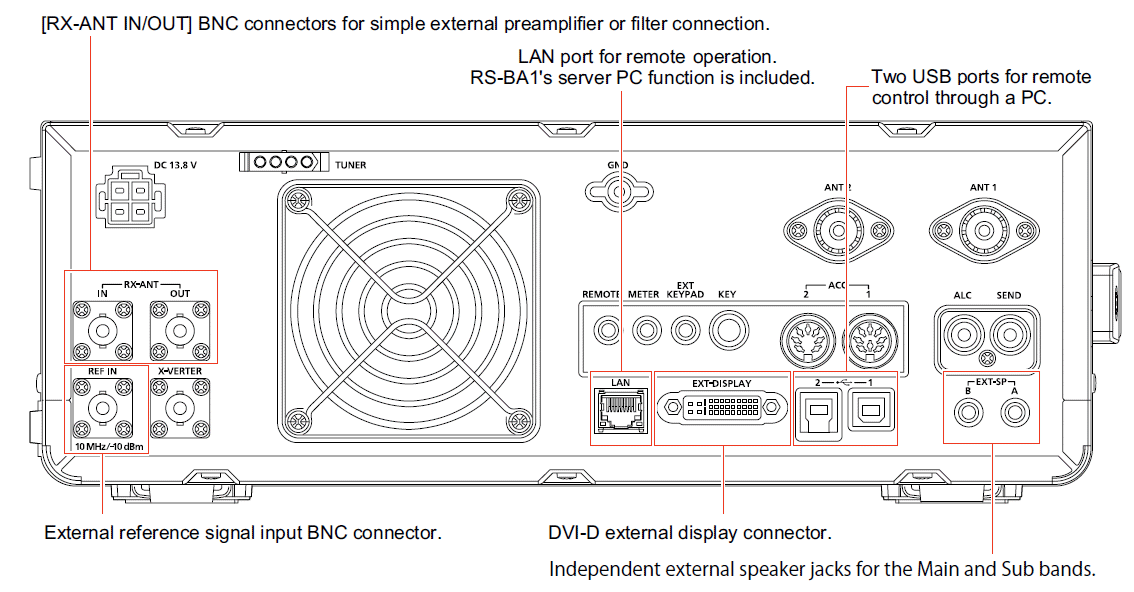
ICOM IC-7610 rear panel description
IC-7610 independent receivers :
The IC-7610 has dual, completely independent, equally high performance receiver circuits for the Main and Sub bands. The circuits are in the stages from the antenna through the Field Programmable Gate Array, (FPGA), as illustrated in figure below. The concept of the IC-7610 is the same as model IC-7851, even though there is a difference in the RF direct sampling system and the double superheterodyne system. Of course the receiver circuits are designed with enough isolation to not have any effect on each other. The received signal is demodulated in the FPGA. However, the demodulation is done in independent demodulators inside the FPGA. The audio amplifier stages are also independent for the Main and Sub bands. The IC-7610 has two antenna connectors. The DUALWATCH operation is possible by selecting different frequency coverage antennas to receive signals, receiving a signal with the diversity method, and connecting horizontal / vertical antennas. This high performance DUALWATCH function enables searching for a signal on the Sub band, while communicating on the Main band.

ICOM IC-7610 receiver overview
IC-7610 independent preselector :
The IC7610 is the first in the mid class HF amateur radio market to employ automatic preselector (DIGI-SEL) circuits as standard. A preselector is a type of RF filter with sharp skirt characteristics. Icom decided that the preselector is a necessary and useful tool in a mid class transceiver, even though up until now, the preselector had only been incorporated into flagship grade transceivers. The IC-7610's independent preselector circuits are built into both the Main and Sub bands.

ICOM IC-7610 automatic preselector
The Reciprocal Mixing Dynamic Range (RMDR) is used as one of the standards representing receiver performance. The RMDR of the IC-7610 is 110 dB, approaching the 116 dB of IC-7851 flagship model. The RMDR is a standard that shows how much the receive sensitivity deteriorates due to blocking from strong adjacent signals. A larger RMDR value means that the blocking effect is less. In general, a lower LO phase noise provides better RMDR characteristics. It is an outstanding improvement of approximately 30 dB in the IC-7610, as the IC-7600 RMDR is approximately 80 dB. You can clearly see this difference in any operating situation.

ICOM IC-7610, 14 MHz RMDR and TX phase noise, comparisons
A transmit signal is directly generated by the FPGA. So, a signal is not generated by mixing several LO signals, like in the superheterodyne system. The purity of a transmit signal, that is generated at the Digital Analog Converter (DAC) using the Digital Up Conversion (DUC) method is extremely high, and this provides improved transmit phase noise characteristics.
IC-7610 spectrum scope :
Dual spectrum scopes with amazing dynamic range is incorporated in the IC-7610. The excellent 100 dB dynamic range of the scope display is achieved by cooperative processing with the FPGA and CPU software. Of course, the sweep speed and resolution are also improved. This spectrum scope can also be used during DUALWATCH operation to show both Main and Sub bands conditions, and its performance is the same in single band operation: span 5~1000 kHz, noise floor -30 dBuV. The waterfall can display received signal history in moving time, and shows weak signals that are difficult to discriminate with only the spectrum scope. The waterfall is simultaneously displayed with the spectrum scope, so you can easily see the details of the band condition and clear frequencies. When you select the expanded screen, a longer history can be displayed on the waterfall. The waterfall is one of the features that increases the possibility to communicate using the optimized IC-7610 receiver performance, without missing weak signals.

IC-7610 FFT scope and audio oscilloscope
The audio scope displays an FFT scope and an oscilloscope, for both transmit and receive audio. The received signal's modulation characteristics, filter width and notch characteristics, and the microphone compression effect of your transmit audio can be displayed. While receiving, audio of either the Main or Sub band can be displayed.
IC-7610 functions :
The IC-7610 has the Multi-dial, the same as the one on the popular IC-7300. This dial makes not only a simple panel layout, without installing individual function knobs, but also makes the operation easier with the addition of the touch operation: TX output power, Microphone gain, Monitor gain, DIGI-SEL, Notch, Notch width, NB level, NB depth, NB width, NR level, APF frequency, APF width, APF level, DRIVE gain. You can also change the settings of the following functions assigned to the multi-function keys with the Multi-dial: VOX gain, ANTI VOX gain, VOX delay time, Compressor level, TX bandwidth, Attenuation level, Break-in delay time.
Two USB connectors are basically to connect a keyboard for PSK or RTTY operation. In addition, the connectors on the IC-7610 can be used for mouse operations on the spectrum scope. The mouse operation enables you to quickly select a signal on the spectrum scope. For this reason, two USB connectors enable you to use to simultaneously use a keyboard and a mouse. You can also connect an optional RC-28 Remote encoder to this connector and use it as your sub-dial. When you insert a USB memory stick to a connector, you can save the memory contents, various transceiver settings, or screen capture data of the IC-7610.
SD card slot. You can save not only memory channel contents and a wide variety of transceiver settings, but also a QSO log for RTTY or PSK operations, and screen capture data, on the SD card memory. For example, when your group participates to a contest as a multi-operator class, an individual operator can quickly start QSOing with their favorite transceiver settings saved on the SD card memory, if each operator saves their favorite transceiver settings in advance. You do not have to waste time manually resetting the transceiver each time the operator changes. It is convenient to reuse the QSO record data, QSO log, or the screen capture, if you store the data on your PC.
TX voice digital memory. The recording time limited to a maximum 30 seconds for only the receive signal has been improved to record unlimited transmit voice as well as receive voice. In addition, the number of voice memory channel is increased from 4 channels to 8 channels. Recording time is also increased from 99 seconds to 200 seconds in total for the 8 channels.
Server function and LAN port. The IC7610 has a server PC function and a LAN port built in. The server PC function is convenient for building your remote control operation through a network using the RS-BA1 optional remote software. You do not need to connect a server PC to the base station. This function and the LAN port make it easier to set up the connections and networking.
External display terminal. The terminal uses the DVI-D (Digital Visual Interface) format, and you do not need settings for the resolution or synchronized frequency on the transceiver. You can monitor the transceiver condition and the receiver condition changes moment to moment with a large external display, the same as the displayed on the front panel display.
BNC connectors for the RX antenna lines. You can install a filter between the RX-ANT connectors to meet your operating needs. This is very useful when using a filter to eliminate unwanted signals. You do not need to be concerned with RF loss on the transmission line by installing the filter on the reception line. As the connectors are installed on the receive line, you can use them for other purposes.
Reference signal input terminal. The IC7610 has a 10 MHz reference signal input terminal installed on the rear panel. The terminal is reliable 50 Ω BNC connector, and is used to process internal signals on the circuits. You can switch a reference signal between the internal and the external signals. The reference signal is one of the important signals to generate transmit and receive signals. It is not actually necessary to apply the reference signal to the terminal externally. However, you can have a more precise frequency if you apply the accurate reference signals externally from a device that has a more accurate signal. If you have several transceivers that have a reference signal input terminal, and if you apply the reference signal from one source signal generator, all your transceivers will have the same frequency accuracy.
Two independent external speaker jacks. The IC-7610 has the DUALWATCH function, you can receive two independent signals simultaneously, in different modes as well as on different bands. Those two different signals are independently output from the external speaker jacks. When you place two external speakers on the right and left sides of the transceiver, you can listen to only the Main or the Sub band audio through the jacks.
IC-7610 price
We have collected for your convenience the ICOM IC-7610 sale price (US Dollar) and its trend over time. Useful to guarantee a cheaper purchase of this radio and to put it for sale in the second-hand market. Of course offers, accessories, warranty terms and conditions can lead to different figures.
|
|
|
|
| USD 3249.95 | 2023-mar | Brand-new |
|
USD 3433.00 (2999EUR) |
2021-oct | Brand-new |
| USD 3199.00 | 2018-oct |
Brand-new In promotion |
IC-7610 review
Your opinion on merits, defects, experiences, with this radio set is welcome. Write your review, after a technical evaluation by our staff if found suitable will be published on this page. We thank you for your precious contribution.
